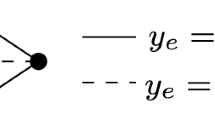Abstract
The graphical relaxation of the Traveling Salesman Problem is the relaxation obtained by requiring that the salesman visit each city at least once instead of exactly once. This relaxation has already led to a better understanding of the Traveling Salesman polytope in Cornuéjols, Fonlupt and Naddef (1985). We show here how one can compose facet-inducing inequalities for the graphical traveling salesman polyhedron, and obtain other facet-inducing inequalities. This leads to new valid inequalities for the Symmetric Traveling Salesman polytope. This paper is the first of a series of three papers on the Symmetric Traveling Salesman polytope, the next one studies the strong relationship between that polytope and its graphical relaxation, and the last one applies all the theoretical developments of the two first papers to prove some new facet-inducing results.
Similar content being viewed by others
References
S. Boyd and W. Cunningham, “Small Traveling Salesman Polytopes,” to appear in:Mathematics of Operations Research.
V. Chvàtal, “Edmonds polytopes and weakly Hamiltonian graphs,”Mathematical Programming 5 (1973) 29–40.
G. Cornuéjols, J. Fonlupt and D. Naddef, “The Traveling Salesman Problem on a Graph and some related Integer Polyhedra,”Mathematical Programming 33 (1985) 1–27.
G. Cornuéjols and W.R. Pulleyblank, “The Traveling Salesman Polytope and {0, 2}-matchings,”Annals of Discrete Mathematics 16 (1982) 27–55.
H. Crowder and M. Padberg, “Solving large scale Symmetric Traveling Salesman Problem to optimality,”Management Science 26 (1980) 485–509.
G. Dantzig, D. Fulkerson and S. Johnson, “Solution of a large scale Traveling Salesman Problem,”Operations Research 2 (1954) 393–410.
A. Elnacheff and J. Fonlupt, “Problème du voyageur de commerce graphique: composition des facettes et des polyèdres,” ARTEMIS-IMAG RT.7 (Grenoble, 1986).
B. Fleischman, “A new class of cutting planes for the Symmetric Traveling Salesman Problem,”Mathematical Programming 40 (1988) 225–246.
M. Grötschel, “On the Symmetric Traveling Salesman Problem: Solution of a 120 city problem,”Mathematical Programming Studies 12 (1980) 61–77.
M. Grötschel,Polyedrische Charakterisierungen Kombinatorisher Optimierungsprobleme (Hain, Meisenheim am Glan, 1977).
M. Grötschel and M. Padberg, “On the Symmetric Traveling Salesman Problem I: Inequalities,”Mathematical Programming 16 (1979) 265–280.
M. Grötschel and M. Padberg, “Polyhedral theory,” in: E. Lawler, J. Lenstra, A. Rinnooy Kan and D. Shmoys, eds.,The Traveling Salesman Problem: A Guided Tour of Combinatorial Optimization (Wiley, New York, 1986).
M. Grötschel and W. Pulleyblank, “Clique tree inequalites and the symmetric Traveling Salesman Problem,”Mathematics of Operations Research 11(4) (1986) 537–569.
E. Lawler, J. Lenstra, A. Rinnooy Kan and D. Shmoys, eds.,The Traveling Salesman Problem: A Guided Tour of Combinatorial Optimization (Wiley, New York, 1985).
D. Naddef, “The Symmetric Traveling Salesman Polytope I: Valid Inequalities derived from the Graphical Relaxation,” Rapport de Recherche ARTEMIS-IMAG 660-M (Grenoble, 1987).
D. Naddef, “The Binested Inequalities for the Symmetric Traveling Salesman Polytope,” to appear in:Mathematics of Operations Research.
D. Naddef and G. Rinaldi, “The graphical relaxation: A new framework for the Symmetric Traveling Salesman Polytope,” to appear in:Mathematical Programming.
D. Naddef and G. Rinaldi, “The Symmetric Traveling Salesman Problem: new facets from the graphical relaxation,” in preparation.
G. Nemhauser and L. Trotter, “Properties of vertex packing and independence system polyhedra,”Mathematical Programming 6 (1974) 48–61.
M. Padberg, “On the facial structure of the set packing polyhedra,”Mathematical Programming 5 (1973) 199–216.
M. Padberg and M. Grötschel, “Polyhedral computations,” in: E. Lawler, J. Lenstra, A. Rinnooy Kan and D. Shmoys, eds.,The Traveling Salesman Problem: A Guided Tour of Combinatorial Optimization (Wiley, New York, 1986).
M. Padberg and S. Hong, “On the Symmetric Traveling Salesman Problem: a computational study,”Mathematical Programming Studies 12 (1980) 78–107.
M. Padberg and G. Rinaldi, “A branch and cut algorithm for the resolution of large-scale symmetric traveling salesman problems,”SIAM Review 33 (1991) 60–100.
W.R. Pulleyblank, “Polyhedral combinatorics,” in: A. Bachem, M. Grötschel and B. Korte, eds.,Mathematical Programming: The State of the Art (Springer, Berlin, 1983).
Author information
Authors and Affiliations
Additional information
This work was initiated while the authors were visiting the Department of Statistics and Operations Research of New York University, and continued during several visits of the first author at IASI.
Rights and permissions
About this article
Cite this article
Naddef, D., Rinaldi, G. The symmetric traveling salesman polytope and its graphical relaxation: Composition of valid inequalities. Mathematical Programming 51, 359–400 (1991). https://doi.org/10.1007/BF01586945
Received:
Revised:
Issue Date:
DOI: https://doi.org/10.1007/BF01586945




